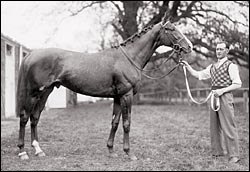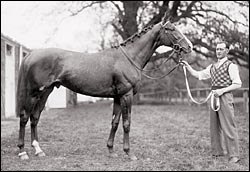BackTrack: Omaha Surges in Belmont to Complete Triple


The nearest counterpart to England's Derby now left in America is the Belmont Stakes (3-year-olds, 1 1/2 miles), endowed for its 67th running with $25,000. The 1935 renewal, at Belmont Park June 8, brought only five starters to the post, so completely had the superiority of Belair Stud's Omaha been conceded. Walter M. Jeffords' Firethorn, closest to Omaha in the Preakness, Foxcatcher Farm Stable's Rosemont, victor over the Belair star in the one-mile Withers Stakes, and Alfred Vanderbilt's Cold Shoulder, fresh from a workout over the Belmont distance in 2:29 2/5, were the only colts whose owners still retained hopes of downing William Woodward's fine racer. The remaining starter, Sir Beverley, is a stablemate of Omaha.
The small field gave Starter George Cassidy little trouble, and was away quickly. Willie Saunders, who was beaten on Omaha in his last previous start, profited by the experience and steered for the rail, saving every possible inch around the first turn. Cold Shoulder was indulged with the lead, and soon had opened a sizeable gap, with Firethorn in second place. Omaha was next, Rosemont, fourth. Sir Beverley, after a half-mile, was simply not in the race. The order was not changed until the field had gone nearly a half-mile. Cold Shoulder had widened his advantage to five lengths, and had not begun to shorten stride. Those who remembered the Vanderbilt colt's fine workout began to believe that the Display colt might hold his lead. No such fear affected Saunders on the Gallant Fox colt, or Raymond Workman on Firethorn. Each was watching the other, careless of how far Cold Shoulder stole into the lead. After seven furlongs Rosemont sprinted past both of them, but neither moved to repulse the Foxcatcher colt. Then, with a half-mile to go, Workman asked Firethorn the question, and the *Sun Briar colt began moving swiftly forward on the inside. Immediately Saunders swung his bat on Omaha, and the Belair crack lengthened stride. The leaders were picked up without the formality of a challenge, and Firethorn entered the stretch in first place, Omaha at his throat-latch. A determined struggle in the stretch carried the leaders far out from the rest of the field. Fifty yards from the finish Omaha had taken the lead, and he drew out to win with a half-length of daylight showing over Firethorn. Rosemont was third, eight lengths behind the Jeffords colt, a length in front of Cold Shoulder. Fifteen lengths farther back came the winner's stablemate, Sir Beverley, eased up after being outrun.
Amid hearty cheering, Saunders brought Omaha back to the winner's circle, the victory being the most popular of the day. There, despite a driving rain, waited Omaha's owner, William Woodward, and the New York banker led in, for the second time in his Turf career, a horse which had won the Kentucky Derby, Preakness and Belmont Stakes in his colors. The first, in 1930, was Gallant Fox, sire of the present 3-year-old champion, now indisputably at the top of his division. Omaha was the third horse to complete the triple, Sir Barton having accomplished the feat in 1919, and was the first to be sired by a horse which had won the three events.
Omaha's victory was worth $35,480, and brought his total earnings to $106,930, of which $103,080 has been won this year. In 15 starts he has won five races, finished second five times, third once. He has won four of his six starts at three, finished once second, once third.
Belmont Park brought its 22-day meeting to an end June 8, after one of the most successful ventures in recent years. Rainy weather on closing day held the crowd to about 20,000, but those who came out were well rewarded. Most of the spectators had come to see Belair Stud's Omaha, already winner of the Kentucky Derby and Preakness, make his bid for the Belmont Stakes, and Omaha turned in a championship performance.
Officials at Belmont Park expressed the belief that the track would not show quite the profits of last spring, but there was no doubt that the meeting would have a comfortable margin of profit, and no doubt, either, that the quality of racing, despite increased competition, was the best seen at the course for many years.
